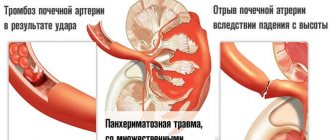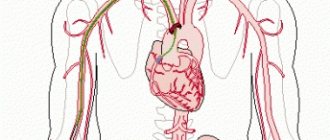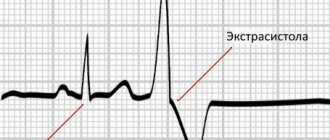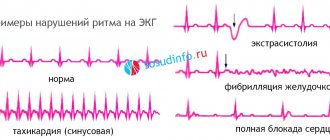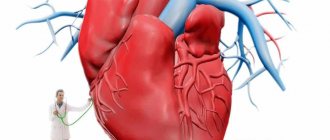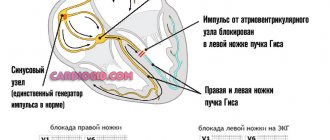The relationship between hypertension and hypothyroidism
With low thyroid function, the formation of its hormones - thyroxine and triiodothyronine - decreases. In response, the brain (hypothalamus and pituitary gland) produces stimulating factors. They act not only on the thyroid gland, but on the entire body as a whole. One of the adverse consequences is high blood pressure due to hypothyroidism.
Several factors are involved in the development of hypertension:
- salt and water retention with swelling of the vascular wall;
- increased cholesterol levels in the blood with the development of atherosclerosis, the arterial membranes become rigid and cannot relax effectively;
- vasospasm in response to rare and weak contractions of the heart;
- decreased response to compounds that dilate blood vessels.
An important role belongs to changes in hormonal levels. In patients, the levels of cortisol and aldosterone in the adrenal glands increase, which lead to persistent hypertension, and the response of the arteries to the action of stress hormones is disrupted.
We recommend reading the article about diet for hypothyroidism. From it you will learn about the rules for constructing a diet for hypothyroidism, what should be limited, the features of the diet for thyroid deficiency, as well as about constructing a menu for the week.
And here is more information about herbs for the thyroid gland.
What is the pituitary gland
Pituitary gland - this term comes from the Latin word hypophysis, which means “process” and has the following synonymous explanations - this is the “lower appendage of the brain”, “pituitary gland”. This is a small organ located in the central part of the brain, well protected by the subcortex of the right and left hemispheres. The pituitary gland is seated in the saddle bones of the skull, which helps protect it from external injury.
The pituitary gland is the smallest organ, which does not affect its functionality and role in the body.
The weight of the pituitary gland ranges from 0.5 to 1 g, which depends on the gender and individual characteristics of the person . There are minor discrepancies in the weight of the pituitary gland between women and men, and between tall and short people. A special category is made up of pregnant women , when the pituitary gland doubles in size in order to provide the mother and baby with a sufficient amount of hormones that are involved in the process of growth and development of the embryo, in the birth process and in milk production.
Interesting! At a period of 4–5 weeks, the structure of the pituitary gland begins to form in the embryo, which continues after the birth of the baby. The pituitary gland reaches its bulk during adolescence, when rapid growth begins not only in length, but also in volume. The reproductive system begins to form, gender characteristics are determined.
Having figured out what the pituitary gland is, you need to consider its structure. Despite the fact that the pituitary gland is small in size and weight, this medullary process is heterogeneous and consists of the following parts:
- The anterior lobe occupies most of the pituitary gland , which accounts for up to 80% of the volume and is involved in the work of the adrenal glands, thyroid gland, testes and ovaries. When pregnancy occurs, this lobe of the pituitary gland produces lactation hormone.
- The posterior lobe is involved in stabilizing blood pressure , controlling water-salt balance and functioning of the reproductive system.
- Intermediate lobe - connects the main lobes of the pituitary gland and acts as a conductor of signals from the hypothalamus, which is involved in the synthesis of hormones secreted by the pituitary gland. The pigment of the skin, hair and eyes is formed under the influence of this lobe of the pituitary gland.
The pituitary gland is the main gland of the endocrine system , which is part of the hypothalamic-pituitary system, which controls the functioning of the peripheral endocrine glands.
Features of the clinical picture
Due to low levels of thyroxine and triiodothyronine in the blood, hypothyroidism occurs with increased blood pressure, as well as the following symptoms:
- weight gain;
- swelling of the face and limbs;
- dry skin, hair with fragility and loss;
- drowsiness, lethargy;
- increased fatigue during normal physical activity, sometimes loss of performance;
- constant chilliness, low tolerance to cold;
- impaired memory, ability to concentrate;
- slurred speech due to swelling of the tongue;
- constipation;
- rare heart rate.
The hypothalamus tries to activate the thyroid gland through the pituitary gland. This leads not only to the expected increase in thyroid-stimulating hormone (TSH), but also stimulates the formation of prolactin. This hormone is responsible for lactation after childbirth, and in men and non-pregnant women it suppresses sexual function.
Therefore, impotence and infertility occur. In both sexes, sexual desire decreases and the mammary glands enlarge. Women are also characterized by a decrease in the volume of menstruation and delays.
Most often, iodine deficiency and autoimmune thyroiditis lead to the development of hypothyroidism. In this disease, the body produces antibodies against the thyroid tissue, which cause an inflammatory process.
At the first stage of the disease, there is a short-term increase in the level of thyroid hormones, and then they steadily decrease.
Hormones that provoke arterial surges
What hormones increase blood pressure? An increase in blood pressure is caused by hormones that can be synthesized by the adrenal glands and thyroid gland, as well as by:
- Thyrotoxicosis.
- Hormones of the steroid group.
- Prolactin.
The table shows the main hormonal molecules, an excess of which can cause arterial surges.
| Group | List of substances |
| Catecholamines | Adrenalin. Norepinephrine. |
| Hormones of the reproductive system | Estrogen. Estradiol. Testosterone. |
| GK | Cortisol. |
| Renal | Angiotensin. Renin. Aldosterone. |
| Antidiuretic hormone | Vasopressin. |
| Hormonal substances that directly affect blood pressure levels | ACTT. Gonadotropic. |
Adrenal hormones
The structure of the adrenal glands consists of two main parts:
- Cortical layer (produces glucocorticosteroids).
- Inner brain (synthesizes catecholamines).
Cortisol can influence blood pressure parameters by increasing heart rate.
The medulla is capable of secreting adrenaline (the fear hormone). Elevated values of adrenaline and noadrenaline substances cause abnormal processes in the cardiovascular system:
- Increased heart rate.
- Increased cardiac output rate.
- Arterial spasm.
- Pupil dilation.
In addition, the increased release of these substances is provoked by pheochromocytoma (a tumor developing in the adrenal medulla).
All these pathological processes aggravate the course of arterial hypertension, causing its exacerbation (hypertensive attack), which is accompanied by severe migraine, severe tachycardia and other pronounced symptoms.
When cortisol levels are persistently high, the following occurs:
- Cushing's disease.
- Hypercorticism.
- Diabetes.
With these pathologies, an overestimated systolic pressure is observed.
Excessive synthesis of aldosterone by the adrenal glands leads to the manifestation of:
- Hyperaldosteronism.
- Kohn's syndrome.
Active production of aldosterone is caused by:
- A neoplasm (usually a benign tumor) in the adrenal glands.
- Excessive growth of adrenal tissue (hyperplasia).
Aldosterone is able to retain fluid and sodium in the vascular walls, while accelerating the excretion of potassium. Such deviations negatively affect the performance of the myocardium and cause pressure surges.
Steroid hormonal substances
In addition to hormones synthesized by the adrenal glands, an increase in blood pressure can occur under the influence of hormonal molecules, which during lactation are responsible for the timely production and release of breast milk:
| Hormones | Peculiarities |
| Prolactin | It affects the female genital organs, which respond to this with the active synthesis of their own hormones. |
| Estradiol | One of the most powerful hypertensive substances that produces estrogens. |
| Estrogens | In turn, after their penetration from the ovaries into the systemic circulation, they spread through the bloodstream throughout the cardiovascular system, causing an increase in vascular tension. As a result, the pressure begins to jump. |
| Estrone and Estradiol | By influencing the myocardium and blood vessels, they increase the concentration of thyroxine T4 in the blood fluid and prevent the manifestation of atherosclerosis. |
| Progesterone | At its low concentration it leads to an increase in blood pressure. |
However, the body does not always respond to changes in estrogen in a timely manner. A delay in the response leads to an increase in their level, which causes the development of many deviations:
- Manifestation of hypertension in adolescents.
- Hyperhidrosis, hot flashes and hyperemia in women with the onset of menopause.
- Jumping blood pressure and active formation of blood clots in men.
Thyroid hormones
Endocrine hormones that affect blood pressure include hormones containing iodine.
Iodine-containing substances that help regulate metabolic processes:
- T3 (triiodothyronine).
- Thyroxine T4 (tetraiodothyronine).
These hormones:
- They are responsible for the normal development of organs, skeletal growth, and brain function.
- They directly affect the cardiovascular system, ensuring the timely supply of the required volume of blood to the necessary organs at a time when a person experiences severe stress and physical tension.
The working functionality of T3 and T4 occurs according to the following scheme:
- When the weather changes rapidly (rapid cooling) or excessive physical effort, the human body experiences emotional stress - the thyroid gland begins to actively synthesize these hormones.
- An increase in their level causes a rush of blood to the surface layers of the body and an increase in temperature to 37 degrees.
Against this background we observe:
- A jump in blood pressure.
- Increased heart rate.
- Increased vascular tone.
- Arterial spasm.
Hyperthyroidism
Thyrotoxicosis (or hyperthyroidism) is a pathological situation in which the thyroid gland intensively produces thyroxine and/or triiodothyronine.
The disease develops as a result of increased work of the thyroid gland or against the background of damage to its cells. Violation of the integrity of the thyroid tissue promotes the penetration into the blood fluid of hormones that were present in the injured cells.
Against the background of an increased amount of thyroid hormones:
- The process of production of adrenaline and norepinephrine substances by the adrenal glands is activated.
- The body's sensitivity to these hormones increases.
As a result, excessive concentrations, especially of norepinephrine, have a negative effect on arterial levels, causing them to increase. When blood pressure jumps:
- The tone of the vascular walls increases.
- The heart muscle works under strain.
This leads to premature wear of blood vessels and the heart. Deterioration of the cardiovascular system has a negative impact on a person’s general well-being:
- Metabolic processes accelerate.
- Unreasonable irritability arises.
- Psycho-emotional stress increases, which cannot be controlled.
- There is a disturbance in heart rhythm.
- Insomnia, hyperhidrosis, shortness of breath and other symptoms develop.
A specific sign of hyperthyroidism is elevated systolic pressure, while the lower one remains normal.
Threat to patients from pressure surges
Arterial hypertension due to damage to the thyroid gland is characterized by the fact that blood pressure and the rhythm of heart contractions change repeatedly throughout the day. This leads to adverse effects on cardiac and cerebral circulation. The consequences of sudden changes in indicators can be:
- heartache;
- dizziness, unsteady gait;
- darkening of the eyes, fainting, especially when changing body position from horizontal to vertical;
- hearing loss, noise in the head;
- painkiller-resistant headache.
Pressure surges complicate the selection of the dose of drugs for the treatment of hypertension. They are considered one of the risk factors for acute blood flow disorders - myocardial infarction and stroke.
A particular danger exists during nighttime and early morning hypertensive crises. They are typical for patients with thyroid dysfunction. Their cause is a large release of vasoconstrictor hormones - cortisol, aldosterone, adrenaline.
Hormonal drugs
Hormonal pills are in first place among drugs that simply need to be treated with suspicion and extreme caution. Some experts doubt the need to use such funds. These drugs always have a lot of contraindications for use, although they are easily available to everyone in pharmacies.
It is important to realize that the effect of hormonal drugs is very strong, because their use without a doctor’s prescription often leads to an overdose of certain hormones.
What consequences might this have? Improper use of medications can lead to severe complications for the entire body: obesity, the formation of blood clots in blood vessels, the development of hypertension and other dangerous diseases. Naturally, hormonal imbalance in the body needs to be treated, but it should be entrusted to a specialist so as not to encounter the unpleasant consequences of an overdose of hormones.
What will help you make a correct diagnosis?
If a patient with hypertension is not diagnosed with thyroid disease in a timely manner, the effectiveness of treatment is usually low. The situation is complicated by the fact that hypothyroidism does not always have obvious manifestations. In some patients it can be detected only by laboratory data:
- decrease in thyroxine and triiodothyronine, increase in TSH;
- blood cortisol, prolactin, aldosterone are above normal or at its upper limit, renin is reduced;
- increase in cholesterol and low-density lipoprotein complexes;
- high concentration of sodium and low potassium salts;
- increased urinary excretion of 17-ketosteroids.
Ultrasound of the thyroid gland
Ultrasound and tomography reveal an increase in the thyroid gland (diffuse goiter, diffuse nodular goiter), and the thickness of the adrenal cortex (hyperplasia).
Hypothyroidism occurs not only in diseases of the thyroid gland itself. It can also be caused by lesions of the pituitary gland. In this case, TSH is reduced. It is characteristic that the pressure in such patients is usually close to normal or even reduced.
In pregnant women and children
Pregnancy does not prevent you from taking the hormone. The drug does not affect the embryo in the first trimester and does not cause gene mutations, since the placental barrier prevents this. In breast milk, the hormone remains in small doses, insufficient to cause disturbances in the physiological development of the child.
In children, the medicine may cause tremors in the arms and legs. The drug should be prescribed with caution, especially if the child has epilepsy or has seizures. "Thyroxine", in this case, can intensify the symptoms, which will worsen the condition.
Is only diastolic always elevated?
The effect of a lack of thyroid hormones on the functioning of the cardiovascular system does not always manifest itself in the same way. Most often, hypothyroidism occurs with high diastolic pressure. However, in elderly patients with widespread atherosclerosis and a long course of the disease, both indicators are increased equally.
However, the degree of hypertension does not always reflect the severity of damage to the thyroid gland. High blood pressure occurs even with subclinical hypothyroidism, which is detected only by blood tests. A stable relationship between hyperthyroidism and hypertension has been established only for 30% of patients; the rest have normal, low and labile (with fluctuations) indicators.
What happens if thyroid pressure is not treated?
Hyper- or hypotension in diseases of the thyroid gland is more severe, more difficult to treat, and more often leads to serious consequences than “true” arterial pathologies.
Constantly high blood pressure affects some organ systems:
- Cardiovascular, leading to atherosclerosis, heart failure, and increased risk of heart attack.
- Nervous. Memory deteriorates, high blood pressure causes brain bleeding and stroke.
- Excretory. Increased pressure damages the renal nephrons, kidney function is impaired, and edema develops.
- Due to impaired blood supply, the retina of the eyes gradually atrophies, which leads to blindness.
With hypothyroidism, cardiogenic shock can occur, characterized by a sharp drop in pulse, blood pressure, and fainting.
Sudden surges in pressure provoke heart attacks and strokes. During pregnancy, hypothyroidism is especially dangerous in a woman: the fetus develops oxygen deficiency, leading to congenital anomalies.
Treatment of hypertension with hypothyroidism
In order to achieve sustainable normalization of blood pressure, you must first restore the function of the thyroid gland.
Drugs for hypothyroidism
The mainstay of treatment for hypertension in hypothyroidism is levothyroxine replacement therapy. The dose of Eutirox or L-thyroxine is selected so that TSH is brought to normal. In this case, special antihypertensive therapy may not be required, or a good result can be achieved with low maintenance doses of drugs.
Correction of other detected hormonal disorders is no less important. If prolactin levels are elevated, Parlodel is included in the treatment, and if there are signs of excess aldosterone, Veroshpiron is needed. They are used in minimal dosages under mandatory blood pressure control. It is recommended to carry out daily monitoring (repeated measurements throughout the day) at least once a month to assess the decrease in daytime and nighttime indicators.
Medicines for hypertension
Blood pressure medications are of minor importance, requiring less than half of patients. They are required for grades 2 and 3 arterial hypertension. It should also be taken into account that the use of levothyroxine has a stimulating effect on the heart, which is undesirable in case of heart diseases (angina pectoris, cardiomyopathy), as well as in old age.
The following groups of drugs for hypertension have proven effectiveness:
- long-acting calcium channel blockers – Norvasc, Plendil;
- angiotensin-converting enzyme inhibitors - Diroton, Prenesa;
- beta blockers that selectively affect the heart - Concor, Nebilet.
If necessary, it is possible to use combinations of medications of the first group with drugs from the second or third, and add diuretics to the treatment. For edema and high blood pressure, it is important to limit the content of table salt in the diet.
We recommend reading the article about the symptoms and treatment of hypothyroidism. From it you will learn about the causes and symptoms of hypothyroidism in men and women, as well as about the diagnosis, treatment of the disease and prevention.
And here is more information about autoimmune thyroiditis.
Hypertension in hypothyroidism occurs due to hormonal and vascular disorders. Its course is characterized by instability of pressure indicators, an increase in diastolic and sometimes systolic levels. To make a diagnosis, it is necessary to conduct blood tests for hormones. Treatment first requires bringing TSH to normal, and then, if necessary, using antihypertensive drugs.
How to restore normal blood pressure
Since in pathologies of the thyroid gland, hyper- and hypotension are a secondary disease, in order to achieve success in normalizing pressure, it is necessary to carry out thyroid therapy.
Medicines
Treatment of arterial hypertension in diseases of the thyroid gland is carried out comprehensively, using the following groups of drugs:
- beta blockers that reduce vascular tone (Egilok);
- alpha-blockers (Prazosin) relieve vascular spasms;
- ACE inhibitors (Capoten), which dilate blood vessels;
- calcium channel blockers (Verapamil);
- potassium-sparing diuretics (Veroshpiron);
- diuretics (Furosemide).
Drugs from different groups are prescribed at the same time. It is more convenient to take tablets containing 2-3 medications, for example, Capozide (Capoten + Hypothiazide).
For low blood pressure, vascular wall tonics (Caffeine, Citramon, Eleutherococcus) and chocolate with a high cocoa butter content (70% or more) are recommended.
Due to numerous contraindications and possible complications, only medications prescribed by a doctor are taken.
Diet and lifestyle
When treating hypertension caused by thyroid diseases, you must follow the recommendations of your doctor:
- stop smoking and drinking alcohol, which negatively affect blood vessels;
- avoid stressful situations, as adrenaline increases blood pressure;
- attend neck massage sessions;
- sleep 7-9 hours, preferably on the right side in a well-ventilated area;
- take regular walks in the fresh air.
It is necessary to eat properly, for which you should exclude fatty and fried foods from your diet, eat less flour and sweets, more vegetables and fruits, use a minimum of salt (no more than 2-3 g per day). If your iodine intake is insufficient, add seafood, buckwheat, grapes, and bell peppers to your food.
Physical training
Physical activity for blood pressure disorders caused by thyroid diseases is a necessary factor in therapy. The positive impact of physical education is manifested in the following:
- metabolism is normalized;
- vascular tone improves, blood pressure stabilizes;
- Stagnation of water in tissues decreases, swelling decreases;
- fat metabolism is activated, weight is reduced;
- improvement of general hormonal status helps to normalize the functioning of the thyroid gland;
- the psychological state returns to normal.
Often, a doctor recommends physical therapy classes, when the trainer selects the optimal load, type of exercise, and duration of classes. If it is not possible to attend exercise therapy, after consultation with a specialist, it is worth developing your own system of sports activities.
The most suitable types of exercise for problems with blood pressure and the thyroid gland are morning exercises, walking, cycling (skiing in winter), visiting the pool, dance classes. In this case, it is necessary to monitor the general condition and count the pulse. The maximum heart rate value is determined by the formula 190 – age, that is, for a 70-year-old person, the pulse should not exceed 120 beats/min after exercise.
Physical education classes should not be carried out if blood pressure readings strongly deviate from the norm, if you feel unwell, have arrhythmia, or have pain in the heart or thyroid gland.
The role of the pituitary gland in the human body
In order to understand what the pituitary gland of the brain is responsible for, you need to know what hormones it produces.
All these protein hormones, necessary for metabolic processes in the body, are produced by the anterior lobe of the pituitary gland. Its posterior lobe is responsible for the production of two other hormones:
- Vasopressin. Protects the body from dehydration by regulating kidney activity and controlling the amount of water excreted in urine. In addition, vasopressin regulates the amount of sodium in the blood, stimulating, if necessary, its excretion from the body along with urine.
- Oxytocin. Responsible for contraction of smooth muscles of the urinary and gallbladder and intestines. Provides contraction of the uterine muscles during labor and also participates in the process of milk production during lactation.
Symptoms of adenoma
Signs of the disease will depend on what kind of pituitary adenoma of the brain has formed, what hormone is produced in excess, the size of the tumor and the rate of its growth.
- Microadenoma. There are 2 types diagnosed: hormonally active and passive. A sign of active disease is the manifestation of endocrine disorders. The passive form may not show itself for years until an MRI is accidentally detected during a study of another disease. Microadenoma is asymptomatic in many people.
- Prolactinoma. A common pituitary adenoma, most cases are diagnosed in women. Manifested by symptoms:
- irregularity or cessation of the menstrual cycle;
- discharge of colostrum from the breast, not associated with breastfeeding;
- difficulties in conceiving children;
- decreased potency in men, swelling of their mammary glands, problems in the formation of sperm.
Somatotropinoma. It is characterized by a high level of growth hormone. All signs of the disease are associated with its level:
- Gigantism appears in children. The child begins to gain weight and his height increases. Gigantism begins to manifest itself in prepubertal age (from 7 to 12 years) and continues until the age of 25. Parents should closely monitor the growth of their children and, if a deviation from the age norm is detected, contact a medical institution to have them examined.
- in adults, symptoms of acromegaly appear when certain parts of the body become enlarged. Facial features become coarser, hair growth increases, many organs increase in size and their functions are disrupted.
Corticotropinoma. Among all cases, adenoma occurs only in 8-10% of patients, including children. Main features:
- obesity. There is a redistribution of fat mass and its deposition in the upper part of the body. The face is rounded. In the lower part of the body, the opposite processes are observed: muscle atrophy occurs. As a result, the lower limbs lose weight.
- skin disorders: stretch marks appear, skin pigmentation increases. Its surface becomes drier and peeling is observed.
- increased blood pressure.
- women experience irregularities in menstruation and increased hair growth.
— in men there is a decrease in potency.
Gonadotropinoma is a rare type of tumor. It manifests itself as a failure of menstruation, a problem with conceiving children. Thyrotropinoma is also a rare adenoma. Its symptoms depend on the shape of the tumor:
- primary: characterized by weight loss, tremors of the limbs or body, poor sleep, increased appetite, sweating, tachycardia, hypertension;
- secondary is distinguished by: swelling of the face, weight gain, slow speech, bradycardia, constipation, peeling of the skin, hoarseness of the voice, depression.
If an incorrect diagnosis is made based on these signs, further development of the adenoma will lead to persistent complications.
Treatment methods
Drug treatment is used when the disruption of the pituitary gland is minor. If the adenoma does not develop, the agonists Lanreotide and Sandostatin are used. To block the production of somatropin, receptor blockers responsible for the process are prescribed. In general, conservative treatment is aimed at normalizing the hormone either by suppressing or replenishing the deficiency. The choice of drug will depend on the stage of the pathology and progression.
To normalize the level of the hormone produced by the adrenal glands, Ketoconazole or Cytadren are prescribed. Dopamine antagonists used in therapy include the following group of drugs: Bromocriptine, Cabergoline. The therapy eliminates the adenoma in 50% of cases and normalizes hormonal levels in 30%. Conservative treatment is not as effective as surgery.
Operative methods
Surgical methods of treating adenoma are resorted to if drug therapy does not give the desired result. In surgery they use:
- The transsphenoidal method is used for microadenomas if the tumor size is small (20 mm) and it has not spread to neighboring organs. A fiber optic endoscope is inserted through the patient's nasal passage to the wedge-shaped wall for subsequent incision. Thus, access to the area of the sella turcica is freed, respectively, to the tumor, which is cut off. The entire surgical procedure is carried out using an endoscope, which displays the process on a monitor. The operation is not classified as complex; the recovery effect is observed in 90% of all cases.
- Transcranial surgery is used in severe cases during craniotomy under general anesthesia. Manipulation is classified as complex. They resort to it when the growth of the adenoma has affected the brain tissue, and the transsphenoidal method has not yielded results.
Also in surgery, the method of radiation therapy is used, in case of low swelling activity, in combination with drug treatment. Using the methods used, it is possible to correct the function of the pituitary gland, but the treatment process and rehabilitation period are difficult and lengthy.
Hypofunction of the pituitary gland refers to endocrine diseases, and the production of hormones from this gland can be reduced or completely stopped. More often this happens with brain injuries, bleeding or genetic disorders.
Important. Decreased pituitary function can develop both in childhood and in adulthood, and for completely unknown reasons.
With this disorder, there may be a deficiency of the following hormones:
- adrenocorticotropic;
- thyroid-stimulating;
- follicle-stimulating and luteinizing;
- somatotropic (growth hormone);
- prolactin;
- antidiuretic (vasopressin);
- oxytocin.
The last two are produced by the posterior lobe of the pituitary gland.
Each of them is responsible for important functions in the body, and accordingly, with their deficiency, disturbances develop in the activity of one or another endocrine gland, and sometimes in the entire organism as a whole.



